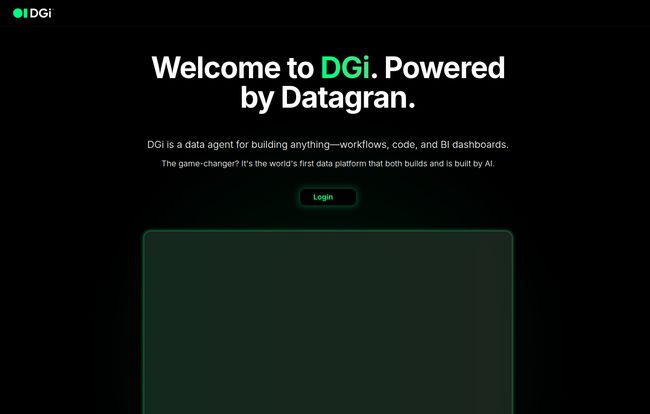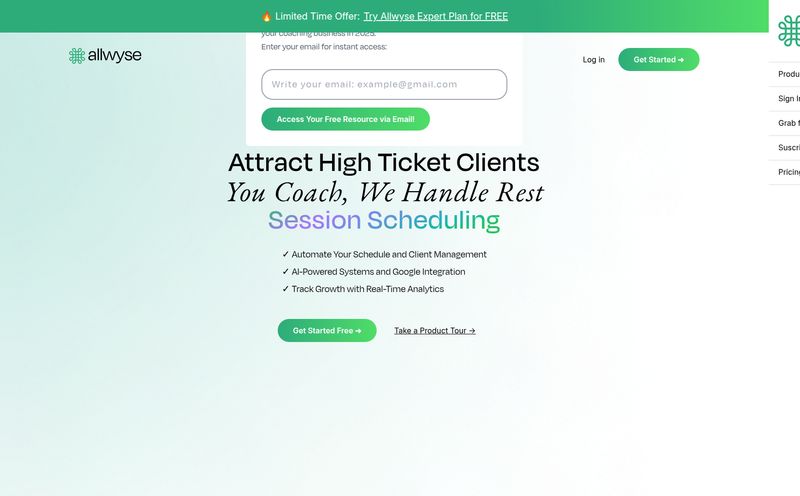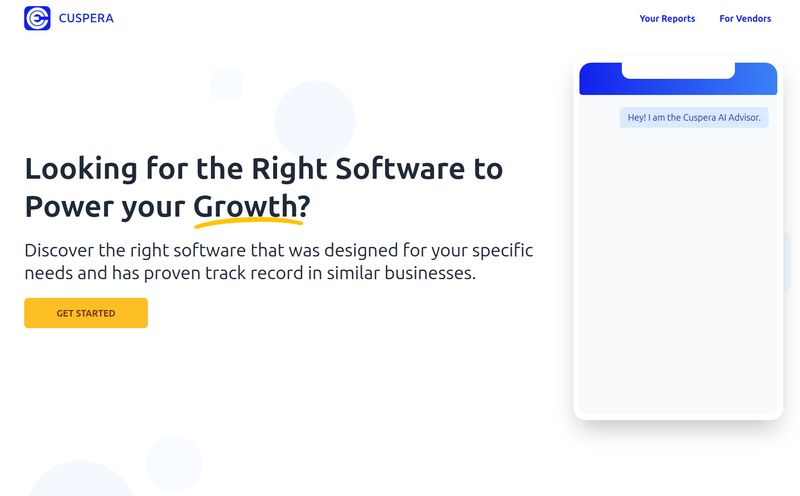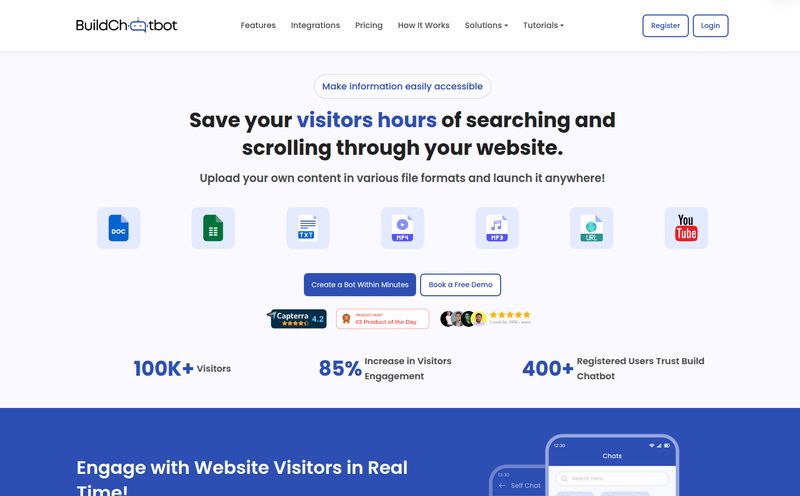I get pitched a lot of AI tools. Every week, my inbox is a graveyard of press releases promising to “revolutionize” something. Most of them are just shiny wrappers on the same old tech. But every now and then, something lands on my desk that makes me lean in a little closer. Something genuinely, and I mean genuinely, weird.
This week, that weird thing is called DGi.
At first glance, the landing page is all cool, dark-mode mystique. It calls itself a “data agent for building anything—workflows, code, and BI dashboards.” Fine. Nothing new there. But then you read the fine print, and that's where my coffee started to taste a little different. DGi claims to be the world's first data platform that both builds and is built by AI.
Wait, what? Read that again. It’s an AI that builds data tools for you, and the tool itself is also built by AI. It’s like a digital amoeba, constantly reshaping itself. My inner sci-fi nerd is screaming, while the professional SEO in me is trying to figure out how the heck to even categorize this thing.
So, What on Earth is DGi (Datagram)?
Let's try to pin this thing down. The creators call it an “experimental Meta Programmable System Generator.” That's a mouthful, so let me translate. Forget everything you know about rigid software with fixed menus and buttons. DGi has no permanent front-end or back-end. It’s a puddle of potential. At its heart is a Large Language Model (LLM), and when you have a task, the AI builds the user interface and the backend logic on the fly to help you accomplish it.

Visit DGi
They call this concept “visual empathy.” Instead of you having to learn the tool's language, the tool learns yours and builds a visual bridge to meet you halfway. You need to connect to a PostgreSQL database and filter for Q3 sales data from your European customers? DGi is supposed to just... generate the interface for that specific task. When you're done, it disappears.
It’s a mind-bending idea. Most data platforms are like a pre-built house. You can move the furniture around, maybe paint the walls, but you can't move the kitchen to the attic. DGi is more like having a pile of intelligent LEGOs that assemble themselves into whatever room you need, and then go back into the box when you're done.
The Backend-less and Frontend-less Promise
For anyone who's ever felt trapped by their tech stack, this is a breath of fresh air. We’ve all been there—stuck with a BI tool that’s 90% perfect but missing that one critical feature, or a workflow automator that can’t quite connect to that one obscure API. The promise of DGi is freedom from those “golden handcuffs.”
Because it isn't locked into a specific framework, it can theoretically be more adaptable. It’s not a React app or an Angular app. It just is. This dynamic UI generation means you only see what you need, when you need it. No more cluttered dashboards with a million options you’ll never touch. It's the ultimate minimalist approach, driven by pure function. I have to say, the ambition is off the charts.
Key Features That Actually Matter
Stripping away the high-concept stuff, what can it do? Well, the list of promised features is pretty much a data analyst's wish list. You can connect it to your databases, have it perform complex analysis and filtering, schedule routine tasks, and spin up business intelligence dashboards. The key difference is the how. Instead of clicking through menus, you're having a conversation with the system, visually and textually.
Imagine telling your data platform, “Show me a week-over-week comparison of user sign-ups versus ad spend for the last six months, and highlight any anomalies.” And instead of you having to perform ten different steps, it just… presents the dashboard. That’s the dream, anyway. The ability to automate not just the task but the creation of the tool for the task is a major conceptual leap.
The Good, The Bad, and The Experimental
I’ve been around the block long enough to know there’s no such thing as a free lunch, especially in tech. As exciting as DGi is, we need a serious reality check.
Where DGi Could Genuinely Shine
The biggest pro is right there in the name: AI-driven automation on a whole new level. For startups and small teams that need to be incredibly agile, a tool like this could be a force multiplier. No need to hire a dedicated data engineer to build a custom dashboard; you just ask the AI. The flexibility is theoretically endless. This could dramatically lower the barrier to entry for sophisticated data analysis, putting powerful tools in the hands of people who aren’t necessarily data wizards.
The Inevitable Reality Check
Okay, deep breath. The word “experimental” is doing a lot of heavy lifting on their website. And for good reason. An AI that builds itself sounds cool, but it also sounds… unstable. What happens when it builds a UI that’s buggy? Who do you file a ticket with, the AI? This reliance on an LLM also means your results are only as good as your prompts. We all know how frustrating it can be to get a chatbot to understand what you want; now imagine that frustration when a multi-million dollar dataset is on the line.
And then there’s the elephant in the room: security. You're hooking this experimental, self-generating AI directly into your company's databases. There’s very little information about the security protocols, guardrails, or data governance features. For any established company, that’s a non-starter. It's a massive leap of faith, and right now, there's not enough information to justify that jump for most businesses.
So, What's the Price of Entry?
This is the part of the review where I’d normally break down the pricing tiers. But with DGi, there’s… nothing. No pricing page, no mention of tiers, no talk of cost at all.
And honestly, that’s the right move for them. This product is so clearly in its infancy, so wildly conceptual, that charging for it now would be foolish. They are almost certainly in a feedback-gathering phase, letting brave pioneers play in their sandbox to see what breaks and what sticks. I’d expect to see a waitlist or an invite-only beta before we ever see a credit card form. It's free, but the price you pay is in being a guinea pig.
Who Is This For, Really?
Let's be blunt. You are not going to roll out DGi to your enterprise sales team next quarter. You just aren't.
This tool is for the trailblazers. It's for the data scientists who have a personal side-project. It's for the startup founder working out of their garage who needs to move lightning fast and is willing to risk things breaking. It’s for the curious, the tinkerers, and anyone who wants a glimpse of what the future of software interaction might look like. It’s for people who get a thrill from being on the bleeding edge, even if it means getting a few cuts along the way. For everyone else, it’s a fascinating development to watch from a safe distance.
My Final Take on This Wild AI Experiment
So, is DGi the future? I don’t know. It’s too early to tell. It feels like watching one of those early Boston Dynamics robot videos – it’s clumsy, a little unsettling, but you can’t deny the incredible potential. The idea of a fluid, ever-changing data platform built by AI is compelling. It challenges the very foundation of what we consider software.
DGi is not a tool you adopt; it's a concept you explore. It’s a bold, slightly crazy experiment that could either fizzle out or lay the groundwork for the next generation of data platforms. I, for one, will be keeping a very close eye on it. This is one rabbit hole I’m more than happy to fall down.
Frequently Asked Questions about DGi
1. What is DGi in simple terms?
Think of DGi as an AI assistant for data. Instead of using a fixed program, you tell the AI what you want to do (like analyze sales data or build a dashboard), and it creates a temporary, visual tool just for that task. It's unique because the AI builds both your tools and itself.
2. Is DGi safe to use with my company's data?
Given its “experimental” nature and the limited information on security protocols, I would be very cautious. It is probably best suited for non-sensitive or public data at this stage. You should not connect it to critical production databases without a thorough security review.
3. How is DGi different from BI tools like Tableau or Power BI?
Tableau and Power BI are established platforms with fixed interfaces and features. You learn how to use their tool. DGi is the opposite; it's a fluid system that builds a custom interface for you based on your specific request. It’s less of a finished product and more of a creation engine.
4. Can I use DGi without knowing how to code?
Yes, that's the core idea. DGi is designed to be used through natural language and visual interaction. The goal is for the AI to handle the code and complex logic behind the scenes, so you don't have to.
5. How much does DGi cost?
Currently, DGi does not have any public pricing information. As an experimental platform, it is likely free to use for early adopters and testers, but this could change in the future.
6. Is DGi just another GPT wrapper?
While it uses an LLM at its core, its claim of having no fixed front-end or back-end and its focus on dynamically generating entire user interfaces and workflows suggests it's more complex than a simple wrapper. It appears to be a unique system architecture built around an LLM, not just passing prompts to it.
Reference and Sources
- DGi Official Website: https://dgi.ai/



